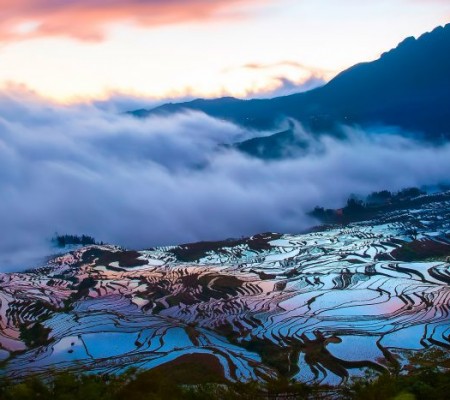
Tourist Attractions Map of Yuanyang Hani Rice Terraces in Honghe
The Honghe Hani Rice Terraces (红河哈尼梯田) are located in the southern part of Yunnan Province (云南省), within the Honghe Hani and Yi Autonomous Prefecture (红河哈尼族彝族自治州). This expansive area spans the counties of Yuanyang (元阳县), Honghe (红河县), Lüchun (绿春县), and Jinping (金平县). The terraces have a cultivation history dating back over 1,300 years to the Sui (隋) and Tang (唐) dynasties .SpringerLink+1中国发现+1ads.yasotrip.com
Geographical Features
The terraces are ingeniously constructed along the contours of the Ailao Mountains (哀牢山脉), descending from elevations over 2,000 meters down to the banks of the Hong River (红河) . In some areas, the terraces number more than 3,700 levels . Villages are typically situated mid-slope, with water channels traversing through them to irrigate the terraces below. This configuration exemplifies the Hani people’s harmonious integration of forest, village, terrace, and water systems.UNESCO World Heritage Centre百度教育
Cultural and Agricultural Significance
The Hani community has developed a sophisticated agricultural system that includes forest conservation, intricate water management, and sustainable farming practices. Their methods reflect a deep understanding of ecological balance and resource utilization, showcasing a unique interaction between humans and their environment.
Core Areas
The core zones of the Honghe Hani Rice Terraces encompass approximately 166.03 square kilometers . Notable areas within this region include:
-
Bada (坝达)
-
Duoyishu (多依树)
-
Laohuzui (老虎嘴)
These areas are renowned for their breathtaking landscapes and are popular destinations for photography and cultural tourism.
Visual Characteristics
The terraces display a dynamic range of colors throughout the year, influenced by weather conditions and the growth stages of crops. On sunny days, the water-filled terraces reflect the sky, appearing blue; on overcast days, they take on a silvery hue; during sunrise and sunset, they glow with golden tones. As crops mature, the terraces transform into vibrant shades of green, yellow, and red, offering a continually changing visual spectacle.
Recognition
In May 2013, the Honghe Hani Rice Terraces were inscribed as a UNESCO World Heritage Site, recognized for their outstanding cultural landscape and sustainable agricultural practices .

 7 Days GolfingTour
7 Days GolfingTour
 8 Days Group Tour
8 Days Group Tour
 8 Days Yunnan Tour
8 Days Yunnan Tour
 7 Days Shangri La Hiking
7 Days Shangri La Hiking
 11 Days Yunnan Tour
11 Days Yunnan Tour
 6 Days Yuanyang Terraces
6 Days Yuanyang Terraces
 11 Days Yunnan Tour
11 Days Yunnan Tour
 8 Days South Yunnan
8 Days South Yunnan
 7 Days Tea Tour
7 Days Tea Tour
 8 Days Muslim Tour
8 Days Muslim Tour
 12 Days Self-Driving
12 Days Self-Driving
 4 Days Haba Climbing
4 Days Haba Climbing
 Tiger Leaping Gorge
Tiger Leaping Gorge
 Stone Forest
Stone Forest
 Yunnan-Tibet
Yunnan-Tibet
 Hani Rice Terraces
Hani Rice Terraces
 Kunming
Kunming
 Lijiang
Lijiang
 Shangri-la
Shangri-la
 Dali
Dali
 XishuangBanna
XishuangBanna
 Honghe
Honghe
 Kunming
Kunming
 Lijiang
Lijiang
 Shangri-la
Shangri-la
 Yuanyang Rice Terraces
Yuanyang Rice Terraces
 Nujiang
Nujiang
 XishuangBanna
XishuangBanna
 Spring City Golf
Spring City Golf
 Snow Mountain Golf
Snow Mountain Golf
 Stone Mountain Golf
Stone Mountain Golf













